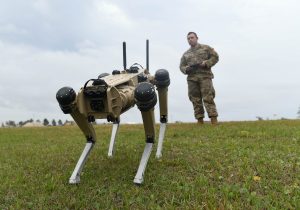Last month, the U.S. Air Force’s Tyndall base received semi-autonomous robot dogs, which are to be deployed in security surveillance roles there, marking the first time the U.S. military has done so.
In a news release published on March 29, the air force has noted that the dogs, designed by private firms Ghost Robotics and Immersive Wisdom, were delivered to the base in Florida on March 22 for integration with the 325th Security Forces Squadron (325th SFS). The Quad-legged Unmanned Ground Vehicles (Q-UGV) – which some might find mildly creepy – “will significantly increase situational awareness for defenders,” the release quoted Mark Shackley, Tyndall AFB Program Management Office security forces program manager, as saying.
“The robot dogs can operate in minus 40-degree to 131-degree conditions and have 14 sensors to create 360-degree awareness. They are also equipped with a crouch mode that lowers their center-of-gravity and a high-step mode that alters leg mobility, among other features,” the release also noted.
The Tyndall AFB has tried to brand itself as the “Installation of the Future,” with “smart-building sensors, increased hurricane wind load levels, and design flood elevation specifications,” and other enhancements to increase resilience, according to military officers responsible for the base.
“Across the base, every squadron has been pushing the envelope of how we do things and expanding our optics of what is possible. One huge attraction piece of the robot dogs is that it’s highly mobile and with the amount of construction we will face over the next few years, it helps us maintain and increase our security posture,” the March 29 air force news release quoted 325th SFS Master Sargent Krystoffer Miller as saying.
In November last year, the U.S. Air Force selected Boca Raton firm Immersive Wisdom to build a 3D Virtual Operations Center at Tyndall AFB through which base security personnel would be able to use the Q-UGV to patrol the base integrating sensor and video data streams in real time.
Commenting on the how the Immersive Wisdom tech will interface with the robots built by Philadelphia-based Ghost Robotics, 325th Security Forces Squadron commander Major Jordan Criss was quoted by an industry news website as saying, “We will be able to see exactly what the robot dog is detecting through its mobile camera and sensor platform if desired, we will also be able to issue verbal commands to a person or people through a radio attached to the dogs.”
Separately, robotics firm Boston Dynamics announced in September last year that their robot dog Spot – which can also be used for surveillance – was available for purchase for commercial use in Canada, European Union and United Kingdom. Spot made news last May when it was, well, spotted in a Singapore park relaying COVID-19 instructions, leading comedian Stephen Colbert to compare the spectacle with scenes from Netflix show “Black Mirror.” Incidentally, a larger, load bearing, variant of Spot – BigDog – was passed over by the U.S. Marine Corps in 2015 because it was a “loud robot that’s going to give away their [marines] position.”
In February, Spot yet again made news after a group of meme-makers equipped it with a paint gun allowing users to use the robotic canine to go on a rampage. At that time, Wired quoted a member of the collective as saying “… if we actually talk candidly about what it’s [Spot] going to be used for in the real world, you could say it’s police, you could say it’s military.”
Colbert’s views on the Tyndall AFB robots remain unknown at the time of filing this story.

































